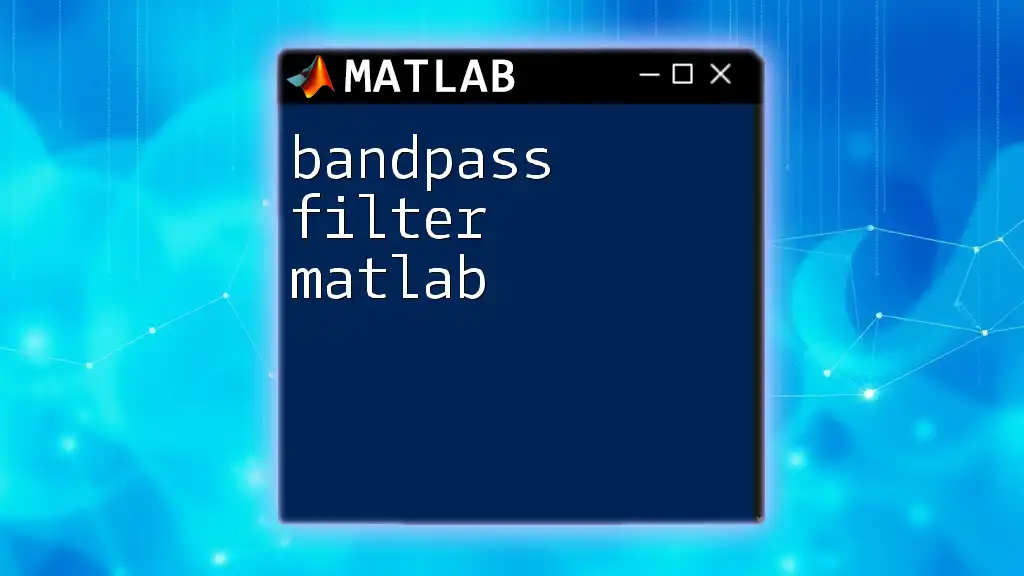A high pass filter in MATLAB is used to allow signals with frequencies higher than a certain cutoff frequency to pass through while attenuating lower frequencies, which can be implemented using built-in functions.
% Design a high pass filter using the butter function
fs = 1000; % Sample frequency
fc = 100; % Cutoff frequency
[b, a] = butter(1, fc/(fs/2), 'high'); % Create a first-order high pass filter
Understanding Frequency Components
What are Frequency Components?
Frequency components refer to the different sine wave signals that combine to form any given signal. In signal processing, a signal can have both low-frequency components (like noise or gradual changes) and high-frequency components (like sharp edges or rapid changes). Separating these components is crucial for improving signal quality and is where high-pass filters come into play.
The Role of Cutoff Frequency
The cutoff frequency is a pivotal point that defines the transition between the passband and the stopband in a filter. It determines which frequencies will be attenuated (blocked) and which will be allowed to pass. In the context of a high-pass filter, frequencies below the cutoff frequency are significantly attenuated while those above are allowed to pass with minimal alteration. Understanding how to set the cutoff frequency is essential for effective filtering in MATLAB.

Types of High-Pass Filters
Analog High-Pass Filters
Analog high-pass filters are constructed using passive or active electronic components like resistors, capacitors, and operational amplifiers. These filters utilize analog signals and can be effective but require careful design to achieve desired frequency characteristics.
Digital High-Pass Filters
Digital high-pass filters operate on digitized signals and are implemented using algorithms. They offer numerous advantages, such as flexibility, precision, and ease of modification. In MATLAB, digital high-pass filters can be designed efficiently, making them preferable for most modern applications.

Implementing High-Pass Filters in MATLAB
Using Built-in Functions
MATLAB provides a set of powerful built-in functions that facilitate the design and application of high-pass filters. One of the primary functions used is `designfilt`, which allows users to specify the type of filter alongside desired characteristics.
Example: Basic High-Pass Filter Design
To create a simple Butterworth high-pass filter, you can use the following MATLAB code:
fs = 1000; % Sampling frequency
fc = 100; % Cutoff frequency
[b, a] = butter(1, fc/(fs/2), 'high'); % Butterworth filter design
In this example:
- `fs` represents the sampling frequency of the signal.
- `fc` is the desired cutoff frequency.
- The `butter` function designs a first-order Butterworth high-pass filter.
This filter will allow frequencies above 100 Hz to pass while attenuating those below this threshold.
Custom High-Pass Filter Design
Creating a High-Pass Filter from Scratch
Designing a high-pass filter from scratch involves understanding the transfer function and filter coefficients. The steps below outline how to create your custom high-pass filter in MATLAB:
% Custom high-pass filter implementation
N = 4; % Filter order
fc = 100; % Cutoff frequency in Hz
fs = 1000; % Sampling frequency
[b, a] = butter(N, fc/(fs/2), 'high'); % Butterworth high-pass filter
In this code:
- `N` specifies the order of the filter, where higher values increase the steepness of the filter response.
- Adjusting `fc` allows you to change the cutoff frequency based on your specific needs.
Frequency Response of High-Pass Filters
The frequency response of a filter indicates how it reacts to different frequencies. In MATLAB, analyzing this response is straightforward using the `freqz` function.
Example: Visualizing Frequency Response
Here is how you can visualize the frequency response of the previously designed high-pass filter:
[h, f] = freqz(b, a, 'half', 1024, fs);
plot(f, abs(h));
title('Frequency Response of High-Pass Filter');
xlabel('Frequency (Hz)');
ylabel('Magnitude');
In this snippet:
- `freqz` generates the frequency response and produces a vector of frequencies `f` and the corresponding magnitudes `h`.
- The `plot` function allows you to visualize how the filter behaves across the frequency spectrum, illustrating that frequencies above the cutoff are preserved while those below are attenuated.

Practical Applications of High-Pass Filters
Image Processing
High-pass filters are extensively used in image processing to sharpen images or detect edges. By removing low-frequency components, you can enhance the visibility of details and refine the quality of images. A typical application might include enhancing the contours of objects within a photograph for better analysis.
Audio Processing
In audio engineering, high-pass filters play a critical role in audio signal processing. They can be used to eliminate low-frequency noise such as hums or pops, thus enhancing the clarity of recorded audio. By applying a high-pass filter to a sound signal, you can ensure that only the relevant high frequencies are preserved, improving overall sound fidelity.

Troubleshooting Common Issues
Filter Instability
Filter instability can occur if the filter design is not executed correctly or if the coefficients are improperly set. Symptoms include unexpected oscillations or output that does not correlate with input signals. To address stability:
- Ensure that filter orders and cutoff frequencies are appropriate for the specific application.
- Consider utilizing lower-order filters for stability.
Phase Distortion
Phase distortion refers to a scenario where different frequency components are shifted in time differently, potentially causing a perception of distortion in audio or visual outputs. To mitigate this, ensure that the design of the filter preserves linear phase characteristics by using such designs as FIR filters or implementing phase equalization techniques to correct any misalignments resulting from the filtering process.

Conclusion
In summary, understanding and implementing high-pass filters in MATLAB can significantly enhance your signal processing capabilities. By mastering filter design and application, you can manipulate and refine signals in various practical contexts, from audio to image processing. As you gain expertise in utilizing these tools, you open up pathways for more sophisticated filtering techniques and applications in your projects.

Additional Resources
For further learning, consider exploring the official MATLAB documentation, online courses, and tutorials that delve deeper into filter design, signal processing concepts, and advanced features in MATLAB relevant to high-pass filters.

















